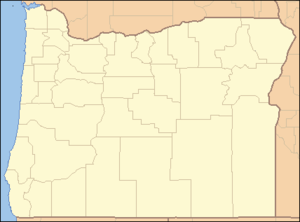Bull Run River (Oregon)
| Bull Run River | |
|
Visitors descend the downstream side of Dam 1 on the Bull Run River.
|
|
| Name origin: Possibly after cattle that escaped and ran wild along the river between 1849 and 1855 | |
| Country | United States |
|---|---|
| State | Oregon |
| County | Clackamas County, Multnomah County |
| Source | Mount Hood National Forest |
| - location | near Bull Run Lake, Clackamas County, Oregon |
| - elevation | 4,259 ft (1,298 m) |
| - coordinates | 45°26′09″N 121°48′39″W / 45.43583°N 121.81083°W |
| Mouth | Sandy River |
| - location | Dodge Park, Clackamas County, Oregon |
| - elevation | 243 ft (74 m) |
| - coordinates | 45°26′46″N 122°14′48″W / 45.44611°N 122.24667°WCoordinates: 45°26′46″N 122°14′48″W / 45.44611°N 122.24667°W |
| Length | 21.9 mi (35.2 km) |
| Basin | 140 sq mi (363 km2) |
| Discharge | for Mount Hood National Forest, 14.8 miles (23.8 km) from the mouth |
| - average | 404 cu ft/s (11 m3/s) |
| - max | 15,800 cu ft/s (447 m3/s) |
| - min | 30 cu ft/s (1 m3/s) |
|
Bull Run River watershed
|
|
The Bull Run River is a 21.9-mile (35.2 km) tributary of the Sandy River in the U.S. state of Oregon. Beginning at the lower end of Bull Run Lake in the Cascade Range, it flows generally west through the Bull Run Watershed Management Unit (BRWMU), a restricted area meant to protect the river and its tributaries from contamination. The river, impounded by two artificial storage reservoirs as well as the lake, is the primary source of drinking water for the city of Portland, Oregon.
It is likely that Native Americans living along the Columbia River as early as 10,000 years ago visited the Bull Run watershed in search of food. Within the past few thousand years they created trails over the Cascade Range and around Mount Hood, near the upper part of the Bull Run watershed. By the mid-19th century, pioneers used these trails to cross the mountains from east to west to reach the fertile Willamette Valley. In the 1890s, the City of Portland, searching for sources of clean drinking water, chose the Bull Run River. Dam-building, road construction, and legal action to protect the watershed began shortly thereafter, and Bull Run water began to flow through a large pipe to the city in 1895.
Erosion-resistant basalt underlies much of the watershed, and streams passing over it are relatively free of sediments. However, turbidity increases when unstable soils sandwiched between layers of basalt and other volcanic rocks are disturbed and wash into the river during rainstorms. Despite legal protections, about 22 percent of the protected zone was logged during the second half of the 20th century, and erosion increased. For a time in 1996, Portland had to shut down the Bull Run supply because of turbidity and switch to water from wells. A law passed later that year prohibited most logging in or near the watershed, and since then the Portland Water Bureau and the United States Forest Service have closed many of the logging roads and removed culverts and other infrastructure contributing to erosion.
...
Wikipedia



